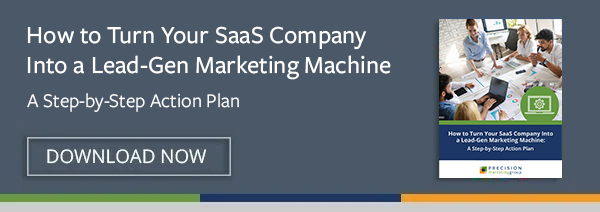Are your SaaS content marketing efforts lagging and you’re not sure why? Are you scratching your head at the lack of qualified leads coming in despite your ambitious content goals?
If this is the case, don’t panic.
Content marketing is a simple enough concept -- but it takes some deeper strategies to really see those metrics soar.
Five SaaS Content Marketing Strategies for Success
- Take a Deeper Dive Into Your SaaS Buyer Persona
- Start Mapping Content to the Buyer’s Journey
- Implement a Smart SaaS SEO Strategy
- Make Repurposing Content a Priority
- Create Content With a Conversion Path In Mind
Here we’ll dive into these no-fail strategies (along with a few common pitfalls that you’ll want to avoid) that will take your SaaS company’s content program from adequate to awesome.
1. Take a Deeper Dive Into Your SaaS Buyer Persona
At the core of every great content strategy are your buyer personas.
HubSpot defines a buyer persona as a semi-fictional representation of your ideal customer based on market research and real data about your existing customers.
Your buyer personas help you understand who, exactly, your ideal buyers are, helping to ensure all of your content is relevant to searching prospects. That’s just the start, though.
For each persona, buyers can further be characterized by their unique thoughts and behaviors from the time they realize they have a problem or opportunity, through the time they choose a solution. This cycle is known as the Buyer’s Journey, and it includes the following three phases:
- Awareness: The buyer realizes they have a problem.
- Consideration: The buyer defines the problem and researches options to solve it.
- Decision: The buyer chooses a solution.
For SaaS companies, a common mistake is to focus on a single stage versus the full journey. This can lead to an editorial calendar that’s too bottom-heavy (i.e., centered around solution-specific product content) or too top-heavy (i.e., broadly addresses industry challenges without leading buyers to an actual solution).
The key to content marketing is to create a robust content plan that connects to your buyers’ mentalities at all stages.
To do this, try to embrace a long-term view. Create your editorial calendar in 3- or 6-month intervals, and tie each topic to a stage of the buyer’s journey to ensure you have the appropriate mix.
Additionally, think about how to mine your subject matter from multiple sources. If writers are working solely with your SaaS product team, for example, then your content may be too narrowly focused on the decision phase.
2. Start Mapping Content to the Buyer’s Journey
Now that you’ve outlined the phases of the Buyer’s Journey, it’s time to get more specific with your ideas. Let’s walk through a fictional example of how you might approach this for a SaaS prospect.
Let’s say your company sells a SaaS solution to help organizations streamline the costly and time-consuming administrative process of hiring and managing contractors.
How would you apply a content strategy that encapsulates each phase of the Buyer's Journey? Try to get in your prospective buyer’s head and think through what content might be appropriate for each phase. For example:
---
Awareness: Prospective buyers are working to identify their problem and give a name to it. You should be asking questions such as:
- What are my buyer’s business challenges and pain points?
- What might be the consequences of inaction in addressing those challenges?
While they are still putting a name to their problem, buyers in this stage know that they struggle with common industry problems, such as high costs and internal inefficiencies.
An appropriate piece of content, then, may be something like: Are Organizational Inefficiencies Cutting Into Your Bottom Line?
---
Consideration: Buyers have clearly defined their goal or challenge, are committed to finding a solution for it, and are researching the different ways to help them address it.
Following our example, buyers are committed to streamlining the inefficient administrative processes that lead to high costs. Your content, therefore, should address the following questions:
- What are the different categories of solutions?
- What are the pros and cons of each solution?
At this stage, your buyer may want to explore solutions by reading an educational blog such as: Contractor Management: 7 Great Ways to Curb Costs.
---
Decision: Buyers in this stage have evaluated different solutions and narrowed it down to one solution category (one of them being your company’s software solution)!
To help them along, your content can address questions including:
- Which criteria will they use to evaluate who to buy from?
- What are some barriers to purchasing that they’ll want to think through?
- How is your particular solution different or unique?
An appropriate piece of content may be a guide or comparison chart: Cost vs Function: How to Choose the Best Contractor Management Software
PRO TIP: For SaaS companies especially, a common pitfall is to focus too much content effort on blogging alone. Your platform is an inherently visual solution. On-demand video demos, testimonials, pricing pages, interactive content, trial & freemium nurture campaigns, and excellent design are also critical to a successful SaaS content strategy.
Using this example as a guide, can you walk through this exercise for your SaaS company?
---
3. Implement a Smart SaaS SEO Strategy
On its own, well-written, editorially compelling content won’t be very effective if search engines can’t find it. A smart SEO strategy is a must; it will help shape your editorial calendar in tandem with the strategies mentioned above.
It’s important to note that SEO keywords alone should not drive your content. You always want to write for human readers, not search engines.
You can, however, take a few key steps to optimize your content and ensure that it gets in front of the right readers.
Keep in mind, the SEO landscape has changed significantly since the early days of keywords.
You’ll want to avoid pitfalls like “keyword stuffing,” or writing blogs that include keywords but lack substance. Search engines will pick up on these tactics! Instead, incorporate an SEO strategy like a pillar/topic cluster model for a long-term, sustainable approach.
Beyond that, some basic on-page SEO optimization for your blogs can go a long way, like the simple best practices below.
- Optimize text elements like title tags, meta descriptions, meta keywords, and URLs
- Optimize image elements including alt tags (which serve as alternate text to your image) and image tags (which show up when someone scrolls over the image)
- Optimize headers - using headers not only makes a text-heavy page scannable; it helps to increase engagement and lower bounce rates. Also, use contextual keywords in your headers where it makes sense. Check out this blog on how to optimize your content to rank for featured snippets.
On-page SEO optimization is a relatively quick and easy step, but it’s a step that’s left until the very end of the writing process -- and therefore, it’s often missed!
PRO TIP: Sometimes, writers focus so much on optimizing their content that they lose sight of the true value to the reader. While optimization is a critical element of your SEO and content strategy, you don’t want to sacrifice true value for keywords. Our advice? Answer questions the way you would if you were talking to a friend or professional colleague, using your keywords only as a guide. At the end of the day, the post that is most helpful to the reader is more likely to rank.
4. Make Repurposing Content a Priority
Too often, marketers focus on new content creation. According to worldometer, blogs in 2020 are published at a steady rate of at least 2 million blogs per day!
The marketing landscape for SaaS companies is particularly crowded, with tens of thousands of SaaS competing for eyeballs.
While new content should absolutely be part of your content marketing strategy, it shouldn’t be the only focus. You don’t need to start from scratch every time. Instead, think about how you can improve your existing content to drive more traffic and generate better results.
Here are just a few examples of how to do that:
- Review blog posts for relevance: Is your blog post referencing SaaS statistics from 2013? Or linking to a research report from a decade ago? Your buyers want content that feels relevant, so remove or refresh those references that are outdated.
- Refresh and republish. Whether you’re optimizing for on-page SEO elements or refreshing content for relevance, republish your blog with a new publish date. This helps retain the SEO authority of your current posts while showing your readers (and Google) that your content is not out of date.
- Rewrite content with an industry-specific spin. Do your prospective SaaS buyers have unique challenges within a particular vertical? Revisit your content library and identify a broad topic to which you can apply an industry-specific focus. Rewrite and repromote that piece with a targeted approach.
The idea of upcycling what you have -- a strategy also known as historical blog optimization -- can be a vital part of your overall content marketing strategy.
Wondering how to find which blogs are good candidates for a refresh? Learn more with this helpful checklist: How to Optimize Historical Blog Content to Increase Traffic.
5. Create Content With a Conversion Path In Mind
Content marketing doesn’t exist in a vacuum. You may write a blog post that ranks well and draws in a high volume of organic searchers. But what about the next step?
Think of each content piece as one step in a larger journey. What is the next logical action for a reader who engages with your content? What additional content will they be interested in?
A common mistake is offering readers a next step that they are simply not ready for. Remember, potential SaaS buyers reading an “awareness phase” blog are probably not ready to speak with a salesperson or sign up for a software demo.
Rather than making "what's next" an afterthought, plan your conversion path before writing begins. That way, you’ll identify where there are holes and fill your content pipeline accordingly.
And, if you map out your content to align with all phases of the buyer’s journey, as outlined in Step #2, you should have plenty of content to create a logical path for readers at every phase of the journey.
---
All in all, SaaS content marketing is not just about writing compelling content. It requires a long-term plan, smart SEO tactics, a diverse mix of topics, and a deep dive into your audience. Once you incorporate these deeper strategies, you’re sure to see the results you’re looking for.




